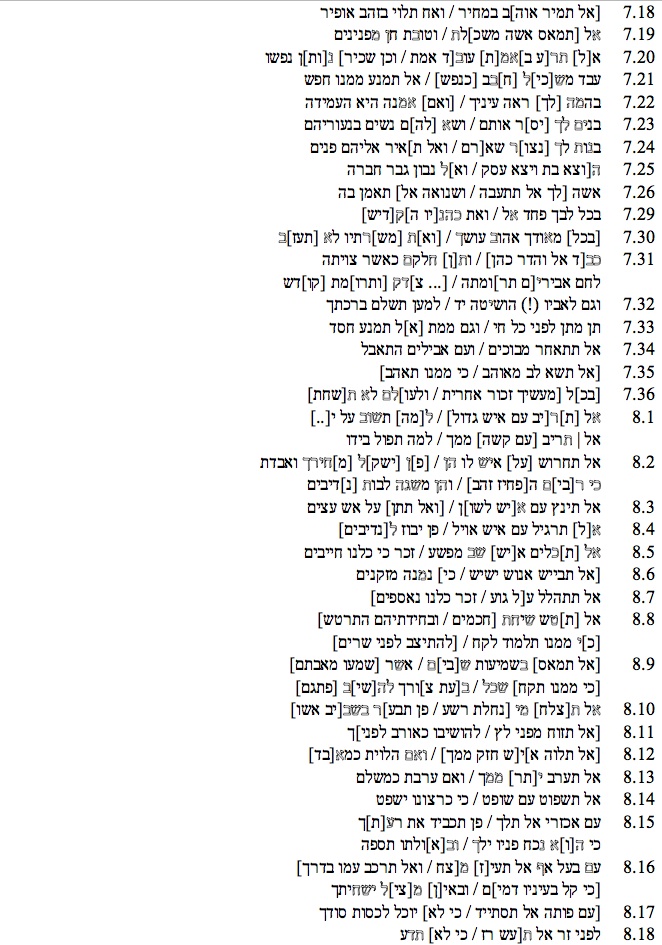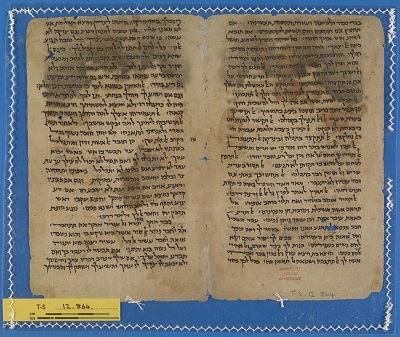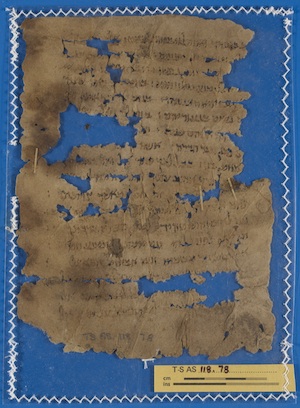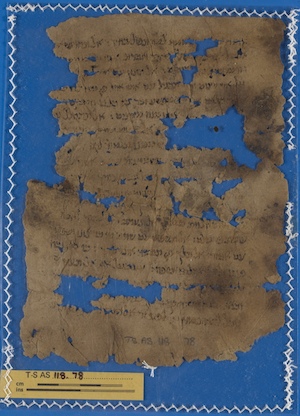A new fragment of the book of Ben Sira, T-S AS 118.78
By Shulamit Elizur and Michael Rand
The original Hebrew text of the apocryphal book of Ben Sira (Ecclesiasticus) lies at the very heart of the story of the discovery of the Cairo Genizah and the subsequent dispersal of its contents to the libraries of Europe and the United States. Indeed, the discovery of the Genizah may be dated to 1865, the year when Jacob Saphir visited the repository in the Ben Ezra synagogue in Fustat, as reported in his book Even Sapir (Lyk, 1866). However, it was not until 1896 that the effort to recover and acquire Genizah manuscripts began in earnest, for this was the year when the twin sisters Agnes Smith Lewis and Margaret Dunlop Gibson returned from a trip to Cairo with a number of leaves from the Genizah that they had succeeded in purchasing. When they showed these leaves to Solomon Schechter at Cambridge University, he quickly recognised among them the remains of the Hebrew Ben Sira. Schechter’s discovery touched off a bitter rivalry between himself and Adolf Neubauer of Oxford University, the object of which was the identification of further fragments of this book. It was in the course of this rivalry that Schechter traveled to Cairo and secured permission to transfer the bulk of the contents of the Genizah to Cambridge University Library (for further details see Reif 1997 and Jefferson 2009).
T-S 12.864 (= ms A), containing Ben Sira 5:10–7:29 and 11:34–14:11
(On the different mss of the Hebrew text of Ben Sira, see the convenient summary in ed. Beentjes, pp. 13ff.)
Within several years of Schechter’s discovery, scholars had discovered over half of the original Hebrew of Ben Sira among the Genizah materials. The search for additional fragments continued over the course of the twentieth century, with impressive results (Reif 1997). To date, fragments stemming from six different manuscripts of Ben Sira have been identified in the Genizah. These manuscripts are conventionally labeled A–F. The Genizah finds, moreover, have been supplemented by manuscripts of even greater antiquity, which have been discovered at Qumran (2Q18, 11QPsa) and Masada (Yadin 1999). All of this material has been brought together in a synoptic edition by P. Beentjes (1997). To it must be added another folio from ms C (Elizur 2010). Two further important editions of the text, both lacking some of the materials that are included in ed. Beentjes, are the edition of Segal (1958) and that prepared in connection with the Historical Dictionary of the Hebrew Language (1973).
The importance of the book of Ben Sira, composed shortly before the Maccabean revolt, for the study of early post-biblical language and literature cannot be overestimated. It provides evidence of the transition from Biblical Hebrew to the Hebrew of the Rabbinic sages. Furthermore, it constitutes a link in the chain of development leading from the poetics of biblical verse to those of the Hebrew liturgical poetry (piyyuṭ) that emerged in Palestine in the Byzantine period.
With the great progress made in the systematic investigation of the Genizah materials in the latter part of the twentieth and the beginning of the twenty-first centuries, the prospects of finding further Ben Sira fragments in the various collections have dwindled significantly. It is against the background of this fact that we must judge the excitement of the discovery of a new fragment in the Additional Series of the Taylor-Schechter Collection: T-S AS 118.78. Here one is reminded of a judgment offered over a decade ago by Stefan Reif: ‘There may be other Ben Sira items lurking among the smaller and less legible contents of some of the Additional Series binders’ (Reif 1997). It is, furthermore, particularly gratifying that this latest fragment bears the name of Schechter, whose life-work is so intimately connected with the discovery of the Genizah in general and the Hebrew Ben Sira in particular.
T-S AS 118.78, recto, the new fragment of Ben Sira, MS D
T-S AS 118.78, verso
The new fragment belongs to ms D, which had been represented up till now by a single leaf from the collection of the Alliance Israélite Universelle in Paris: ID 1 (Lévi 1900). It contains the text of Ben Sira 7:18–8:18, all of which is also attested in ms A (7:20–21, 23–25; 8:7 are also attested in ms C). The overlap is fortunate, as the new fragment is in a very poor state of preservation, so that its numerous lacunae can be filled in from the parallel source. On the other hand, because of the existence of the parallel source, the new fragment does not add significant new text to what had previously been known of the Hebrew Ben Sira, though a few letters missing in ms A can now be filled in. However, its reading in 7:31 may well provide a clue to the solving of an old interpretive problem. (We hope to treat this matter in a later publication.) The fragment was identified at the Ezra Fleischer Institute for the Research of Hebrew Poetry in the Genizah, in the course of the systematic cataloguing of the poetic fragments contained in the T-S Additional Series. The initial identification was made by Sarah Cohen, the Institute’s researcher, and was confirmed by the Institute’s director, Shulamit Elizur. Below, we present a transcription of the fragment, with the lacunae filled in on the basis of ms A (according to the transcription in ed. Beentjes).
Symbols:
[..] = lacuna of less than one word in the text
[…] = lacuna of one word or more in the text
outline font = uncertain reading
| = end of recto

Bibliography
P. C. Beentjes, The Book of Ben Sira in Hebrew: a Text Edition of all Extant Hebrew Manuscripts & A Synopsis of All Parallel Hebrew Ben Sira Texts (Leiden/New York/Köln, 1997)
Sh. Elizur, ‘Two New Leaves of the Hebrew Version of Ben Sira’, Dead Sea Discoveries 17 (2010), 13–20
Historical Dictionary of the Hebrew Language, The Book of Ben Sira: Text, Concordance and an Analysis of the Vocabulary (Jerusalem, 1973) [Hebrew]
R. J. W. Jefferson, ‘A Genizah secret: the Count d’Hulst and letters revealing the race to recover the lost leaves of the original Ecclesiasticus’, Journal of the History of Collections 21 (2009), 125–142
I. Lévi, ‘Fragments de deux nouveaux manuscrits hébreux de l’Écclésiastique’, Revue des Études Juives 40 (1900), 1–30
S. C. Reif, ‘The Discovery of the Cambridge Genizah Fragments of Ben Sira: Scholars and Texts’, in P. C. Beentjes ( ed.), The Book of Ben Sira in Modern Research: Proceedings of the First International Ben Sira Conference 28–31 July 1996 Soesterberg, Netherlands (Berlin, 1997), 1–22
M. Segal, Sefer Ben Sira ha-Shalem (Jerusalem, 1958)
Y. Yadin, ‘The Ben Sira Scroll from Masada’, in Sh. Talmon, Hebrew Fragments from Masada (Jerusalem, 1999), 151–252 [revised edition of Y. Yadin, The Ben Sira Scroll from Masada (Jerusalem, 1965)]
Cite this article
Contact us: genizah@lib.cam.ac.uk
The zoomable images are produced using Cloud Zoom, a jQueryimage zoom plugin:
Cloud Zoom, Copyright (c) 2010, R Cecco, www.professorcloud.com
Licensed under the MIT License



